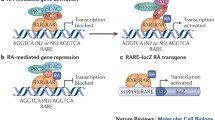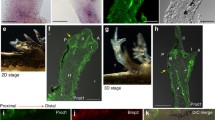Abstract
Retinoic acid (RA) and the family of molecules based on vitamin A known as retinoids have remarkable effects on limb regeneration in salamanders and newts and cause whole limb duplications in a concentration-dependent manner. They respecify all three axes of the limb—the proximodistal, the anteroposterior, and the dorsoventral axis. As a result, complete limbs can be induced to regenerate from distal amputation planes producing two limbs in tandem. Here, we describe the basic methods for undertaking these experiments as well as the use of new synthetic retinoids which have retinoic acid receptor-selective actions. These will be valuable tools in future studies on the molecular basis of limb duplications and thus our understanding of the nature of positional information in the regenerating salamander limb.
Access this chapter
Tax calculation will be finalised at checkout
Purchases are for personal use only
Similar content being viewed by others
References
Niazi IA, Saxena S (1978) Abnormal hindlimb regeneration in tadpoles of the toad, Bufo andersonii, exposed to excess vitamin A. Folia Biol (Krakow) 26:3–8
Maden M (1982) Vitamin A and pattern formation in the regenerating limb. Nature 295:672–675
Maden M (1983a) The effect of vitamin A on the regenerating axolotl limb. J Embryol Exp Morph 77:273–295
Thoms SD, Stocum DL (1984) Retinoic acid-induced pattern duplication in regenerating urodele limbs. Dev Biol 103:319–328
Niazi IA, Pescitelli MJ, Stocum DL (1985) Stage dependent effects of retinoic acid on regenerating limbs. Wilhelm Roux Arch Dev Biol 194:355–363
Lheureux E, Thoms SD, Carey F (1986) The effects of two retinoids on limb regeneration in Pleurodeles waltl and Triturus vulgaris. J Embryol Exp Morph 92:165–182
Ju B-G, Kim W-S (1994) Pattern duplication by retinoic acid treatment in the regenerating limbs of Korean salamander larvae, Hynobius leechii, correlates well with the extent of dedifferentiation. Dev Dynam 199:253–267
Maden M (1983b) The effect of vitamin a on limb regeneration in Rana temporaria. Dev Biol 98:409–416
Scadding SR, Maden M (1986a) Comparison of the effects of vitamin a on limb development and regeneration in Xenopus laevis tadpoles. J Embryol Exp Morph 191:35–53
Stocum DL, Thoms SD (1984) Retinoic acid-induced pattern completion in double anterior limbs of urodeles. J Exp Zool 232:207–215
Ludolph DC, Cameron JA, Stocum DL (1990) The effect of retinoic acid on positional memory in the dorsoventral axis of regenerating axolotl limbs. Dev Biol 140:41–52
Kim W-S, Stocum DL (1990) Retinoic acid modifies positional memory in the anteroposterior axis of regenerating axolotl limbs. Dev Biol 114:170–179
Wigmore P (1990) Serially duplicated regenerates from the anterior half of the axolotl limb after retinoic acid treatment. Rouxs Arch Dev Biol 198:252–256
Mohanty-Heijmadi P, Dutta SK, Mahapatra P (1992) Limbs generated at site of tail amputation in marbled balloon frog after vitamin a treatment. Nature 355:352–353
Maden M (1993) The homeotic transformation of tails into limbs in Rana temporaria by retinoids. Dev Biol 159:379–391
Vandersea MW, Fleming P, McCarthy RA, Smith DG (1998) Fin duplications and deletions induced by disruptions of retinoic acid signaling. Dev Gene Evol 208:61–68
Rutledge JC, Shourbaji AG, Hughes LA, Polifka JE, Cruz YP, Bishop JB, Generoso WM (1994) Limb and lower-body duplications induced by retinoic acid in mice. PNAS USA 91:5436–5440
Niederreither K, Ward SJ, Dolle P, Chambon P (1996) Morphological and molecular characterization of retinoic acid-induced limb duplications in mice. Dev Biol 176:185–198
Liao X, Collins MD (2008) All-trans retinoic acid-induced ectopic limb and caudal structures: murine strain sensitivities and pathogenesis. Dev Dynam 237:1553–1564
Tickle C, Alberts B, Wolpert L, Lee J (1982) Local application of retinoic acid to the limb bond mimics the action of the polarizing region. Nature 296:564–566
Scadding SR, Maden M (1986b) Comparison of the effects of vitamin a on limb development and regeneration in the axolotl, Ambystoma mexicanum. J Embryol Exp Morph 91:19–34
Satre MA, Kochhar DM (1989) Elevations in the endogenous levels of the putative morphogen retinoic acid in embryonic mouse limb-buds associated with limb dysmorphogenesis. Dev Biol 133:529–536
Chambon P (1995) The molecular and genetic dissection of the retinoid signaling pathway. In: Recent progress in hormone research. Academic Press, London, pp 317–332
Ragsdale CW, Gates PB, Hill DS, Brockes JP (1993) Delta retinoic acid receptor isoform is distinguished by its N-terminal sequence and abundance in the limb regeneration blastema. Mech Dev 40:99–112
Maden M, Chambers D, Monaghan J (2018) Chapter 7: Retinoic acid and the genetics of positional information. In: Regenerative engineering and developmental biology. CRC Press, Boca Raton, pp 163–180
Koussoulakos S, Sharma KK, Anton HJ (1988) Vitamin a induced bilateral asymmetries in Triturus forelimb regenerates. Biol Struct Morph 1:43–48
Maden M, Keeble S, Cox RA (1985) The characteristics of local application of retinoic acid to the regenerating axolotl limb. Rouxs Arch Dev Biol 194:228–235
Acknowledgments
Research concerning the activity of RAR agonists was supported by the National Science Foundation (IOS 1558017).
Author information
Authors and Affiliations
Corresponding author
Editor information
Editors and Affiliations
Rights and permissions
Copyright information
© 2023 The Author(s), under exclusive license to Springer Science+Business Media, LLC, part of Springer Nature
About this protocol
Cite this protocol
Maden, M., Polvadore, T. (2023). Retinoic Acid–Induced Limb Duplications. In: Seifert, A.W., Currie, J.D. (eds) Salamanders. Methods in Molecular Biology, vol 2562. Humana, New York, NY. https://doi.org/10.1007/978-1-0716-2659-7_17
Download citation
DOI: https://doi.org/10.1007/978-1-0716-2659-7_17
Published:
Publisher Name: Humana, New York, NY
Print ISBN: 978-1-0716-2658-0
Online ISBN: 978-1-0716-2659-7
eBook Packages: Springer Protocols




